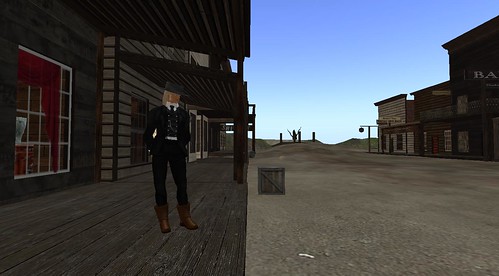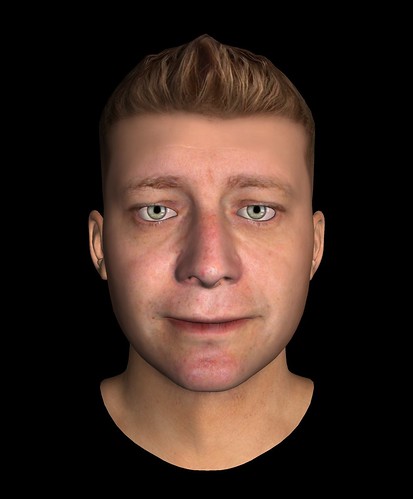The last few days have seen some bluster created by Lily Allen in a very similar way to Metallica back in the early days of P2P file sharing. I was interested to see this sensible and well executed response to some of the arguments.
It is one of those subject that we see time and time again. It is generally regarded as a binary decision. You either do things and get paid for them or you do things and people steal them. This is an emotive subject in virtual worlds too not just the music business.
I do not condone theft, but I think that theft or sharp practice works both ways. A creator of something can be profiteering or milking a product for all its worth. There is a balance to be had here.
If I look at my own business here at Feeding Edge, there are things I do that are done for different forms of payment, or for things as loss leaders, I put things out there specifically for people to copy, a thought or an idea. That is because I am not motivated by high end greed, that is the corporate mentality that has caused the world so many problems the last few years. At the same time, of course, there are bills to pay and lives to live.
Finding that middle ground, being able to use some peoples things giving them appropriate credit (either financial or opening them up to audiences) needs to happen across all industry. Those that only take whether they are the apparent bad guys who copy and steal content, or those that take because they are being unreasonable in pricing and usage of their “product” are just as bad as one another.
If something really is of value, someone somewhere will have honour enough to pay in all sorts of ways. The music industry should not look on people are resources to tax. It is precisely because of passionate evangelists for emerging bands, products, ideas etc that freely distribute ideas and content that those become marketable and “successful”.
There is no easy answer on how to transition from that free thinking to a product/consumer mentality and it may be that old thinking clashing with the opportunities afforded by mass communication has yet to evolve.
If you like things, help the people that build them. Support them, talk about them, pay them if you can (me included).
You have to explore, its the wild west
All the virtual world work I do, whilst having a playful side to it is still all about business, my Second Life interactions in particular I have some very good friends but we are all in the business. We talk about making things, persuading people, and share some experiences we have had. Travel in virtual worlds also broadens the mind. Having explained in my previous post, and in the presentations this week that places like Second Life mean lots of things to lots of people and those things can coexist it was by chance I read New World Notes and saw about a roleplay sim for Deadwood. This is historical recreation, there are actually more rules than you would find in a business meeting, to ensure the immersion of character is not broken. Now I love westerns, and I really enjoyed the Deadwood series. So… I joined up.

It was interesting of course that I had to alter my look in order to enter. So the fun of shopping and choosing at least the first outfit and getting a hat to fit was taking me back to the first days in SL. However, I am still maintaining the high degree of honour and strength that one would associate with the scifi predator. i.e. don’t prey on the weak.
So, in the course of a few days I have spoken in world in at “serious” work event, jumped over to a feeding edge consulting piece of work building some very advanced training facilities, and now slipped into something that made me feel slightly nervous and gave me the sense of exploration I had nearly 4 years ago.
I literally bumped into a community leader as I arrived in Deadwood, and those initial conversations really set the tone. These role play arenas have a fascinating feel to them as once again they are more like acting than gaming. Even Eve and Wow there feels a detachment for the purposes of the game. Who knows how long I will survive or how much I can immerse myself, but I am intrigued (and unarmed I should add!).
This is of course work in some sense, in experiencing this type of use of a virtual world, and being in it, whilst at the same time being part of the industry I am soaking up anecdotes for other people to hear about.
Explaining Second Life inside and out
This week I had the pleasure of driving to the NEC in birmingham and presenting the a body of people attending the Events UK trade show. The presentation was quite last minute, I was offered the chance to fill in for Linden Lab/Second Life.
The show came in two parts. The first was presenting at the NEC live, the second was doing the same presentation in Second Life so that there could be a compare and contrast.
The show featured myself, Justin Bovington(Rivers Run Red) and Kevin Aires(GPJ) with moderation by Adam Coulter for the Institute of Travel and Meetings(ITM)
The NEC version was an interesting stage open and in the corner of Hall 8. The other corner past all the trade stands was a battle of the bands expo. This made for some interesting competing sounds for us and the delegates. I was accompanied by a Michael Jackson tribute and Kevin was battling against a version of the Kings of Leon Sex on Fire. Justin had some guitars to compete with though it may have been an original tune.
This was of course out of anyone control in the hustle and bustle of a trade conference. It does of course highlight a massive benefit of a virtual environment where you can make sure that you only get the distractions you want, passers by etc. So it became part of the conversation when we did the SL rerun of it all.
You cannot get away from the irony of an audience question “So what are the measurable benefits of business meetings in a virtual world”, and having to ask them to speak up because the guitars drowned out the question 🙂
In world was interesting too, as clearly doing a pitch about SL in SL does not really need the powerpoints. For Justin he was really showing the Immersive Workspaces off by us all being in there, and for Kevin, as he was talking about alternatives and different ways of getting online interaction again we were already in there.
We were using streaming media for the slides, as we all know this is to stop uploading and giving away textures to Second Life for a ppt, to help show there is a secure way to share visuals. However as we all know some people have problems, the play button, the quicktime install etc. So I had some IM’s saying a few people could not see the slides. Handily I had my rezzable clothing presentation and used that to both illustrate the point was on, but also to illustrate the dynamic nature and benefits of being in a virtual world such as Second Life.
I think both shows went very well, reenforcing the fact that this is not going away, there are challenges, but also huge advantages and interesting tradeoffs.
The presentation I used is below. Some of the slides are really just the basics, a vehicle to explain what this is all about people and immersion and engagement with one another and with information.
As I was writing this post I also went over and commented on the great infoworld piece pointing out “19 Century thinking wont cut it in Second Life”
I have pasted my comment here too to avoid repeating myself too much 🙂
“I have been helping enterprises and individuals alike get used to the changes and ways of working online for a long while. As a metaverse evangelist I spend time with anyone who needs hear why, or what, virtual worlds are and what context they can be used in. Due to the visual nature of the environments people often have to go through the stages of exploration that start with “can I do exactly what I do at the moment in here?”. The classic being, if we have a serious business meeting can I show powerpoint? Once you get people into the environment it is much easier to show that there really is no need to restrict yourself to one screen or one room layout. We use ppt in real meetings because we only have one projector and one screen, we cant alter the size or mood of a room or environment. So locking into this area of mirror world thinking is really missing the point and benefits of a dynamic evolving space that can be used to explore the data or subject of any gathering. There is also an assumption that because we are dealing with a technology that in some way this is just one thing, one way of working or engaging. in reality it is a vessel for people and the things people need to communicate. It is the web, but with people live in it too. Hence I am never surprised at any objections that people throw at the technology, but really is is that they are being challenged to work with people in a richer way. You are not hiding behind a mass email you are in the place with the people who need to hear what you have to say. When people attempt to classify any virtual world but focus on one thing they dont like about a particular one it really is like saying they don’t like all literature because some people write historical dramas and they don’t like historical dramas. Many of us in the industry are quite used to these potential misdirected objections and fears (though they are valid if people have them). “I don’t have time to contribute to x, to blog, to twitter to go into a virtual world” – I usually ask what they do spend time doing, wasted travel time, responding to CC emails, waiting for teleconference calls to start rather than being more efficient. “I am not a gamer” – Well its not about games, it can be but its not games. You can send something playful in an email as much as a serious statement, you dont regard email as a game. “People lie and cheat and misrepresent” – Some do yes, but they do that in the office and con men convince people via all sorts of means. Again this is just a medium, a place for things to happen. “There is sex there” – Yes there is, it is the internet, you do not choose to not have a company website just because other people use the web for other means. The list goes on, but the benefits of the degree of engagement that you can have, not to replace face to face, but to enhance your online interactions when you cant move your carbon atoms around the planet are undeniable. You don’t have to use all the tools all the time either, this is not an either or. For me the greatest benefit to a virtual world gathering is memory of where it happened and who was there. As with all memory aids keying into a space and place gives a common context. Which is easier to reference when following up “In the course of the teleconference held on the 9th September at 2:45 pm you mentioned a new product development” or “You know when we were sitting on the park bench in Dublin last week and you mentioned..” or “We were just coming up to the 9th hole at the golf course and..” Space and relative context to one another is important to human communication, social and business, and yes business and social can mix and do already very nicely.”
Are you pointing that thing at me?
The appstore is now starting to fill up with AR applications. The next is Robot Vision thanks Tish for Tweeting it 🙂
So there we go, open up the things already on the device to the development community and we have leapt from a really subtle launch of what we used to call location based services for those simpler apps, “find an x” near me. Almost overnight in tech terms we now have magic window and magic mirror Augment Reality apps on a highly used highly consumer orientated device.
There is not really even time to use the word tipping point is there!
Bionic Eye – Augmented Reality on the Iphone (officially)
@kohdspace just tweeted this piece of news from Mobile Crunch.
After what amounted to some terms of service violation hacks where people built AR applications for the iPhone it seems that this Bionic Eye is an official AppStore approved version.
I don’t have an iPhone (yet) despite being a registered iPhone developer, but if the api’s are released and working I expect a huge flood of AR applications, and I suspect there are some very clever ideas yet to be implemented.
I want to be able to create my relationship between the data and the real world using a mirror world or control deck in 3d in somewhere like Second Life and then be able to effectively push new AR overlays and contexts out to people.
I think this will feel a little like the renamed Operation Turtle now called Hark but for AR. In fact Hark is a handy name isn’t it as it already has AR letters in it. There I go thinking out loud and inventing things.
I would love to hear if anyone has this bionic eye app already, or if anyone is working on a mashup with the virtual worlds we already have rather than just GPS overlays.
Using the Evolver Clone. Is that me?
Yet more experiments with Evolver. I tried using the single photo upload and then adjusting the regsitration points on the face. The result is interesting I think.

It was from this delightful glasses removed picture of my goodself. See what you think.

As an avatar augmentalist rather than a realist I think I prefer the more extreme cartoon or enhanced avatars to the photo real. I was getting a little bit of personal uncanny valley each time I try pasting my face into something. So I will stick with the previous AV for now.
The inchventure – come on in.
There a few days left to join in the fun in round 2 of Jerry Paffendorf’s innovative project to create a network of inch size land parcels in Detroit linked with virtual land too. Its intriguing and fun to think where this will go.
To quote from http://7billionfriends.com/
“In my pursuit of ever cooler, grander, more meaningful things that use the network to mix physical stuff with virtual stuff and products with stories, I’ve been working on a project in the wild and wooly city of Detroit, Michigan called LOVELAND: http://makeloveland.com .
In its simplest terms I’m inviting people to move into Detroit for $1 a square inch. More abstractly but importantly, the attraction is to create a tiny new globally networked city within the city that people around the world can own, inhabit, and create in. The physical space will also be mirrored online through “The Inchernet” so in addition to physical scaping it’s perfect for digital creatives like you (games, sites, worlds, models, augmented reality, etc).”

What’s not to love about this ? So Feeding Edge is joining in as you might expect, come join us.
Heading for the NEC Birmingham
I have just been asked to present on the subject of Second Life and what it is all about at this event next week (23rd, and on the 24th in Second Life itself). I don’t think this is the right venue for all of my washing away cave paintings pitch but one that needs more of the whats this all about then style that I have of course done a fair few times :).
The event is for the Institute of Travel and Meetings so it is a great audience to help along the path with a bit of evangelism.

I am sharing the card with two well known names. The first being Justin Bovington from Rivers Run Red and the other my fellow ex IBMer Kevin Aires now of George P Johnson.
